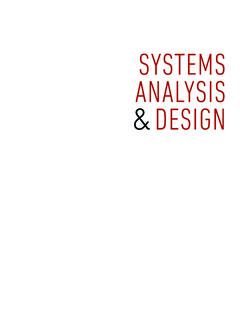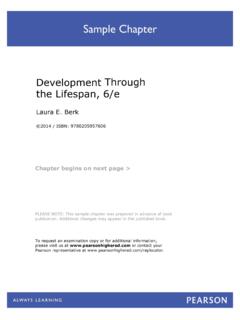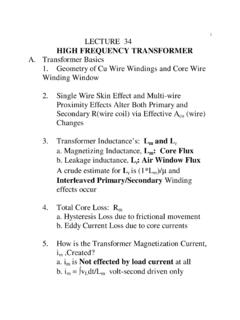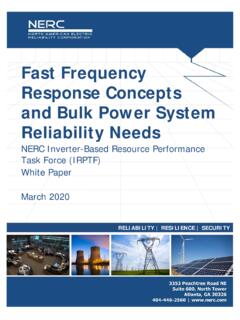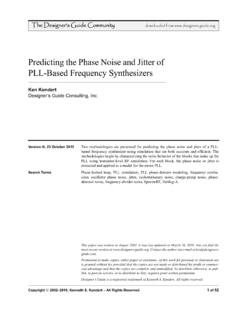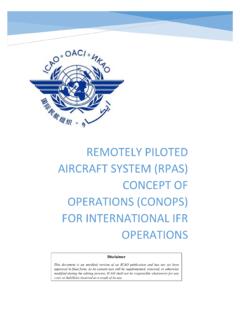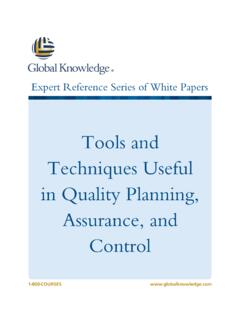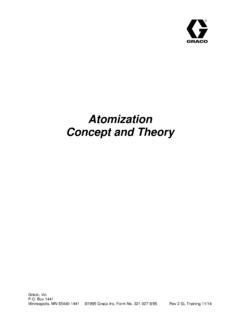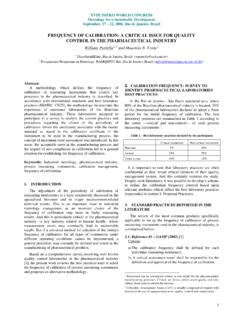Transcription of The Cellular Concept— System Design Fundamentals
1 57 CHAPTER3 The Cellular concept System Design FundamentalsThe Design objective of early mobile radio systems was to achieve a large coveragearea by using a single, high powered transmitter with an antenna mounted on a tall tower. Whilethis approach achieved very good coverage, it also meant that it was impossible to reuse thosesame frequencies throughout the System , since any attempts to achieve frequency reuse wouldresult in interference. For example, the Bell mobile System in New York City in the 1970s couldonly support a maximum of twelve simultaneous calls over a thousand square miles [Cal88].Faced with the fact that government regulatory agencies could not make spectrum allocations inproportion to the increasing demand for mobile services, it became imperative to restructure theradio telephone System to achieve high capacity with limited radio spectrum while at the sametime covering very large IntroductionThe Cellular concept was a major breakthrough in solving the problem of spectral congestionand user capacity.
2 It offered very high capacity in a limited spectrum allocation without anymajor technological changes. The Cellular concept is a System -level idea which calls for replac-ing a single, high power transmitter (large cell) with many low power transmitters (small cells),each providing coverage to only a small portion of the service area. Each base station is allo-cated a portion of the total number of channels available to the entire System , and nearby basestations are assigned different groups of channels so that all the available channels are assignedto a relatively small number of neighboring base stations. Neighboring base stations are assigneddifferent groups of channels so that the interference between base stations (and the mobile usersunder their control ) is minimized.
3 By systematically spacing base stations and their Page 57 Tuesday, December 4, 2001 2:17 PM58 Chapter 3 The Cellular concept System Design Fundamentalsgroups throughout a market, the available channels are distributed throughout the geographicregion and may be reused as many times as necessary so long as the interference between co-channel stations is kept below acceptable the demand for service increases ( , as more channels are needed within a particularmarket), the number of base stations may be increased (along with a corresponding decrease intransmitter power to avoid added interference), thereby providing additional radio capacity withno additional increase in radio spectrum. This fundamental principle is the foundation for allmodern wireless communication systems, since it enables a fixed number of channels to serve anarbitrarily large number of subscribers by reusing the channels throughout the coverage , the Cellular concept allows every piece of subscriber equipment within a countryor continent to be manufactured with the same set of channels so that any mobile may be usedanywhere within the frequency ReuseCellular radio systems rely on an intelligent allocation and reuse of channels throughout a coverageregion [Oet83].
4 Each Cellular base station is allocated a group of radio channels to be used within asmall geographic area called a cell. Base stations in adjacent cells are assigned channel groupswhich contain completely different channels than neighboring cells. The base station antennas aredesigned to achieve the desired coverage within the particular cell. By limiting the coverage area towithin the boundaries of a cell, the same group of channels may be used to cover different cells thatare separated from one another by distances large enough to keep interference levels within tolerablelimits. The Design process of selecting and allocating channel groups for all of the Cellular base sta-tions within a System is called frequency reuse or frequency planning [Mac79].Figure illustrates the concept of Cellular frequency reuse, where cells labeled with thesame letter use the same group of channels.
5 The frequency reuse plan is overlaid upon a map toindicate where different frequency channels are used. The hexagonal cell shape shown inFigure is conceptual and is a simplistic model of the radio coverage for each base station, but ithas been universally adopted since the hexagon permits easy and manageable analysis of a cellularsystem. The actual radio coverage of a cell is known as the footprint and is determined from fieldmeasurements or propagation prediction models. Although the real footprint is amorphous innature, a regular cell shape is needed for systematic System Design and adaptation for futuregrowth. While it might seem natural to choose a circle to represent the coverage area of a base sta-tion, adjacent circles cannot be overlaid upon a map without leaving gaps or creating overlappingregions.
6 Thus, when considering geometric shapes which cover an entire region without overlapand with equal area, there are three sensible choices a square, an equilateral triangle, and ahexagon. A cell must be designed to serve the weakest mobiles within the footprint, and these aretypically located at the edge of the cell. For a given distance between the center of a polygon andits farthest perimeter points, the hexagon has the largest area of the three. Thus, by using thehexagon geometry, the fewest number of cells can cover a geographic region, and the hexagonclosely approximates a circular radiation pattern which would occur for an omnidirectional Page 58 Tuesday, December 4, 2001 2:17 PMFrequency Reuse59station antenna and free space propagation.
7 Of course, the actual Cellular footprint is determined bythe contour in which a given transmitter serves the mobiles using hexagons to model coverage areas, base station transmitters are depicted as eitherbeing in the center of the cell (center-excited cells) or on three of the six cell vertices (edge-excitedcells). Normally, omnidirectional antennas are used in center-excited cells and sectored directionalantennas are used in corner-excited cells. Practical considerations usually do not allow base stationsto be placed exactly as they appear in the hexagonal layout. Most System designs permit a base sta-tion to be positioned up to one-fourth the cell radius away from the ideal understand the frequency reuse concept , consider a Cellular System which has a total of Sduplex channels available for use.
8 If each cell is allocated a group of k channels (k < S), and if theS channels are divided among N cells into unique and disjoint channel groups which each havethe same number of channels, the total number of available radio channels can be expressed as( )The N cells which collectively use the complete set of available frequencies is called acluster. If a cluster is replicated M times within the System , the total number of duplex channels,C, can be used as a measure of capacity and is given by( )ABCGFEDBGFEACDGFEBCDAF igure Illustration of the Cellular frequency reuse concept . Cells with the same letter use thesame set of frequencies. A cell cluster is outlined in bold and replicated over the coverage this example, the cluster size, N, is equal to seven, and the frequency reuse factor is 1/7 sinceeach cell contains one-seventh of the total number of available Page 59 Tuesday, December 4, 2001 2:17 PM60 Chapter 3 The Cellular concept System Design FundamentalsAs seen from Equation ( ), the capacity of a Cellular System is directly proportional to thenumber of times a cluster is replicated in a fixed service area.
9 The factor N is called the clustersize and is typically equal to 4, 7, or 12. If the cluster size N is reduced while the cell size is keptconstant, more clusters are required to cover a given area, and hence more capacity (a larger valueof C) is achieved. A large cluster size indicates that the ratio between the cell radius and the dis-tance between co-channel cells is small. Conversely, a small cluster size indicates that co-channelcells are located much closer together. The value for N is a function of how much interference amobile or base station can tolerate while maintaining a sufficient quality of a Design viewpoint, the smallest possible value of N is desirable in order to maximizecapacity over a given coverage area ( , to maximize C in Equation ( )).
10 The frequency reusefactor of a Cellular System is given by 1/N, since each cell within a cluster is only assigned 1/N ofthe total available channels in the to the fact that the hexagonal geometry of Figure has exactly six equidistant neigh-bors and that the lines joining the centers of any cell and each of its neighbors are separated by mul-tiples of 60 degrees, there are only certain cluster sizes and cell layouts which are possible [Mac79].In order to tessellate to connect without gaps between adjacent cells the geometry of hexagons issuch that the number of cells per cluster, N, can only have values which satisfy Equation ( ).( )where i and j are non-negative integers. To find the nearest co-channel neighbors of a particularcell, one must do the following: (1) move i cells along any chain of hexagons and then (2) turn60 degrees counter-clockwise and move j cells.





